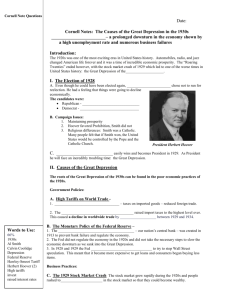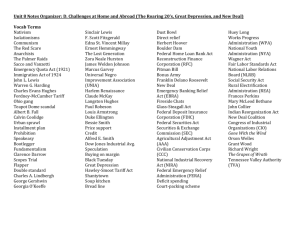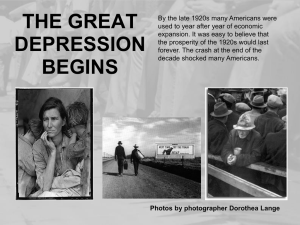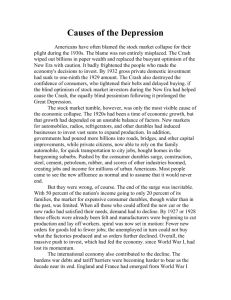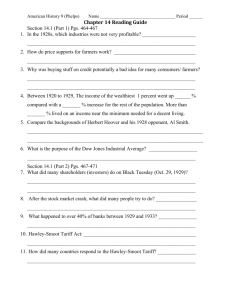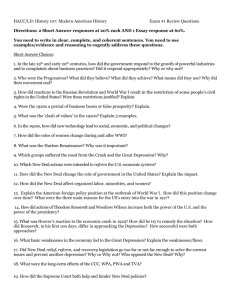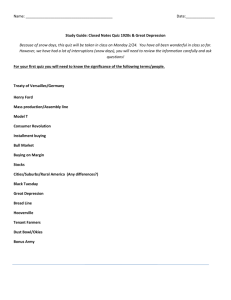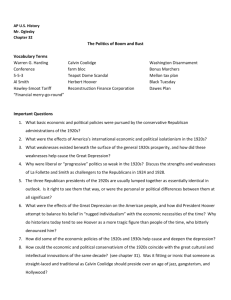Great Depression Causes
advertisement
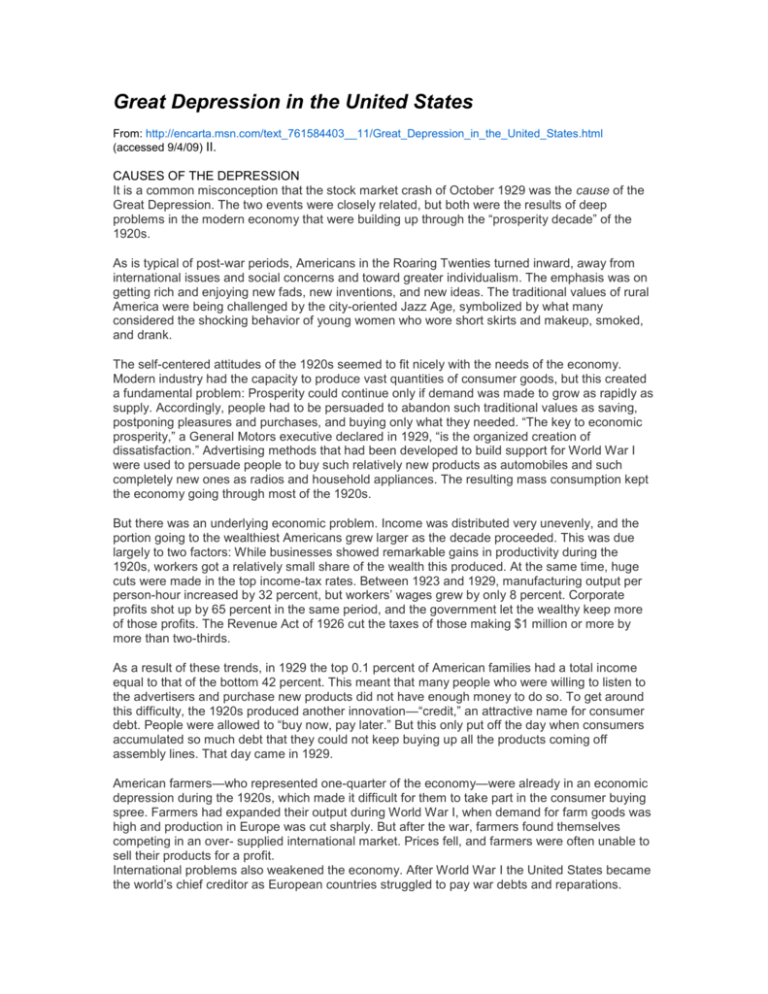
Great Depression in the United States From: http://encarta.msn.com/text_761584403__11/Great_Depression_in_the_United_States.html (accessed 9/4/09) II. CAUSES OF THE DEPRESSION It is a common misconception that the stock market crash of October 1929 was the cause of the Great Depression. The two events were closely related, but both were the results of deep problems in the modern economy that were building up through the “prosperity decade” of the 1920s. As is typical of post-war periods, Americans in the Roaring Twenties turned inward, away from international issues and social concerns and toward greater individualism. The emphasis was on getting rich and enjoying new fads, new inventions, and new ideas. The traditional values of rural America were being challenged by the city-oriented Jazz Age, symbolized by what many considered the shocking behavior of young women who wore short skirts and makeup, smoked, and drank. The self-centered attitudes of the 1920s seemed to fit nicely with the needs of the economy. Modern industry had the capacity to produce vast quantities of consumer goods, but this created a fundamental problem: Prosperity could continue only if demand was made to grow as rapidly as supply. Accordingly, people had to be persuaded to abandon such traditional values as saving, postponing pleasures and purchases, and buying only what they needed. “The key to economic prosperity,” a General Motors executive declared in 1929, “is the organized creation of dissatisfaction.” Advertising methods that had been developed to build support for World War I were used to persuade people to buy such relatively new products as automobiles and such completely new ones as radios and household appliances. The resulting mass consumption kept the economy going through most of the 1920s. But there was an underlying economic problem. Income was distributed very unevenly, and the portion going to the wealthiest Americans grew larger as the decade proceeded. This was due largely to two factors: While businesses showed remarkable gains in productivity during the 1920s, workers got a relatively small share of the wealth this produced. At the same time, huge cuts were made in the top income-tax rates. Between 1923 and 1929, manufacturing output per person-hour increased by 32 percent, but workers’ wages grew by only 8 percent. Corporate profits shot up by 65 percent in the same period, and the government let the wealthy keep more of those profits. The Revenue Act of 1926 cut the taxes of those making $1 million or more by more than two-thirds. As a result of these trends, in 1929 the top 0.1 percent of American families had a total income equal to that of the bottom 42 percent. This meant that many people who were willing to listen to the advertisers and purchase new products did not have enough money to do so. To get around this difficulty, the 1920s produced another innovation—“credit,” an attractive name for consumer debt. People were allowed to “buy now, pay later.” But this only put off the day when consumers accumulated so much debt that they could not keep buying up all the products coming off assembly lines. That day came in 1929. American farmers—who represented one-quarter of the economy—were already in an economic depression during the 1920s, which made it difficult for them to take part in the consumer buying spree. Farmers had expanded their output during World War I, when demand for farm goods was high and production in Europe was cut sharply. But after the war, farmers found themselves competing in an over- supplied international market. Prices fell, and farmers were often unable to sell their products for a profit. International problems also weakened the economy. After World War I the United States became the world’s chief creditor as European countries struggled to pay war debts and reparations. Many American bankers were not ready for this new role. They lent heavily and unwisely to borrowers in Europe, especially Germany, who would have difficulty repaying the loans, particularly if there was a serious economic downturn. These huge debts made the international banking structure extremely unstable by the late 1920s. In addition, the United States maintained high tariffs on goods imported from other countries, at the same time that it was making foreign loans and trying to export products. This combination could not be sustained: If other nations could not sell their goods in the United States, they could not make enough money to buy American products or repay American loans. All major industrial countries pursued similar policies of trying to advance their own interests without regard to the international economic consequences. The rising incomes of the wealthiest Americans fueled rapid growth in the stock market (see Stock Exchange), especially between 1927 and 1929. Soon the prices of stocks were rising far beyond the worth of the shares of the companies they represented. People were willing to pay inflated prices because they believed the stock prices would continue to rise and they could soon sell their stocks at a profit. The widespread belief that anyone could get rich led many less affluent Americans into the market as well. Investors bought millions of shares of stock “on margin,” a risky practice similar to buying products on credit. They paid only a small part of the price and borrowed the rest, gambling that they could sell the stock at a high enough price to repay the loan and make a profit. For a time this was true: In 1928 the price of stock in the Radio Corporation of America (RCA) multiplied by nearly five times. The Dow Jones industrial average industrial average—an index that tracks the stock prices of key industrial companies—doubled in value in less than two years. But the stock boom could not last. The great bull market of the late 1920s was a classic example of a speculative “bubble” scheme, so called because it expands until it bursts. In the fall of 1929 confidence that prices would keep rising faltered, then failed. Starting in late October the market plummeted as investors began selling stocks. On October 29, known as Black Tuesday, the worst day of the panic, stocks lost $10 billion to $15 billion in value. By mid-November almost all of the gains of the previous two years had been wiped out, with losses estimated at $30 billion. The stock market crash announced the beginning of the Great Depression, but the deep economic problems of the 1920s had already converged a few months earlier to start the downward spiral. The credit of a large portion of the nation’s consumers had been exhausted, and they were spending much of their current income to pay for past, rather than new, purchases. Unsold inventories had begun to pile up in warehouses during the summer of 1929. The crash affected the economy the way exposure to cold affects the human body, lowering the body’s resistance to infectious agents that are already present. The crash reduced the ability of the economy to fight off the underlying sicknesses of unevenly distributed wealth, agricultural depression, and banking problems. 1. Discuss possible causes of the Great Depression 2. What cultural values might be linked to the causes of the U.S. Great Depression?

